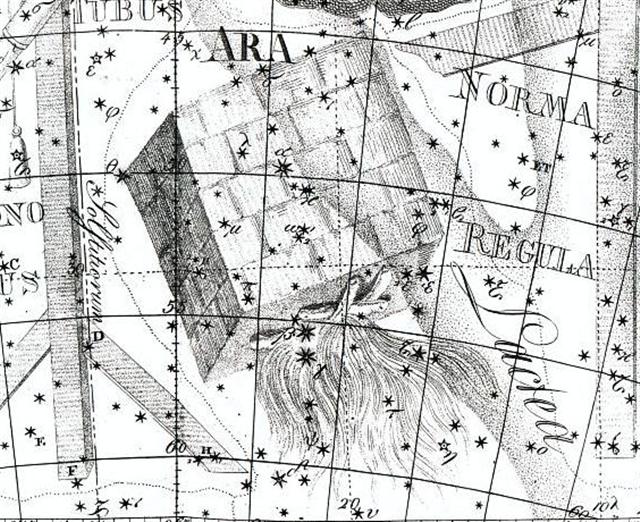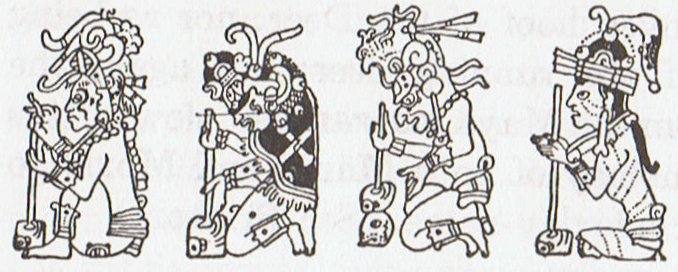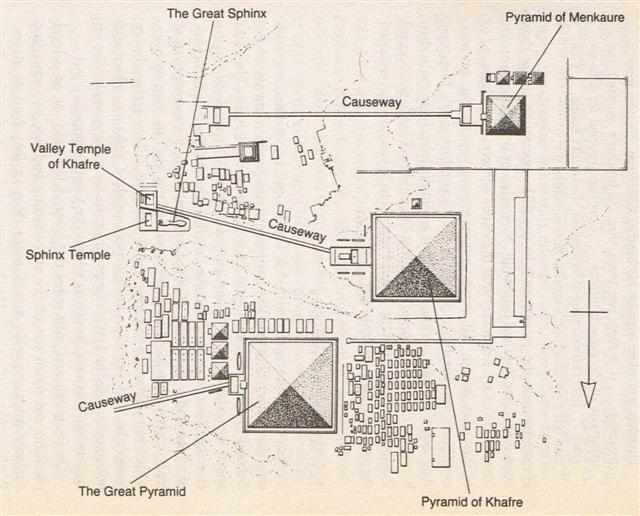167. In ancient Egypt there
were 3 great burial pyramids for the
3 great Pharaohs who had 'gone to sleep' (moe)
- they were not permanently dead and gone
for ever, only re-cycled to re-turn in a later
generation:
... And
then the bone spoke; it was there in the
fork of the tree: Why do you want a mere
bone, a round thing in the branches of a
tree? said the head of One Hunaphu when it
spoke to the maiden. You don't want it, she
was told.

I do
want it, said the maiden. Very well. Stretch
out your right hand here, so I can see it,
said the bone.
Yes, said the maiden. She stretched out her
right hand, up there in front of the bone.
And then the bone spit out its saliva, which
landed squarely in the hand of the maiden.
And then
she looked in her hand, she inspected it
right away, but the bone's saliva wasn't in
her hand. It is just a sign I have given
you, my saliva, my spittle. This, my head,
has nothing on it - just bone, nothing of
meat. It's just the same with the head of a
great lord: it's just the flesh that makes
his face look good. And when he dies, people
get frightened by his bones. After that, his
son is like his saliva, his spittle, in his
being, whether it be the son of a lord or
the son of a craftsman, an orator.
The
father does not disappear, but goes on being
fulfilled. Neither dimmed nor destroyed is
the face of a lord, a warrior, craftsman, an
orator. Rather, he will leave his daughters
and sons ...
 |
 |
 |
|
Cb2-8 (392 + 32) |
Cb2-9 (425 = 365 + 60) |
Cb2-10 (407 + 19) |
|
Niu |
moe te goe |
 |
 |
|
mago |
Cb2-10 |
Mago.
Spotted dogfish,
small shark. Vanaga.
Mogo,
shark. P Pau.: mago, id.
Mgv. mago, id. Mq. mano,
mako, mono, moko id. T. maó,
id. In addition to this list the
word is found as mago in
Samoa, Maori, Niuē, and in Viti as
mego. It is only in Rapanui
and the Marquesas that we encounter
the variant mogo. Churchill.
 |
 |
326 |
 |
38 |
|
Toki |
Ga2-1 |
Cb2-5 |
|
CANOPUS (*95) |
ALCYONE (*56) |
Toki. Small
basalt axe. Vanaga. Stone adze. Van
Tilburg. Ha'amoe ra'a toki =
'Put the adze to sleep' (i.e. hide
it in the temple during the night).
Barthel. Month of the ancient
Rapanui calendar. Fedorova
according to Fischer. To'i.
T. Stone adze (e to'i purepure
= with the wounderful adze). Henry.
The
Araukan Indians in the coastal area
of northern Chile, have customs
similar to those on the Marquesas
and in both areas toki means
adze according to José Imbelloni.
The Araukans also called their chief
of war toki and the
ceremonial adze symbolized his
function and was exhibited at the
outbreak of war. In Polynesia
Toki was the name of a chief
elevated by the Gods and his sign
was the blade of a toki.
Fraser.
Axe,
stone hatchet, stone tool ...;
maea toki, hard slates, black,
red, and gray, used for axes T. P
Pau.: toki, to strike, the
edge of tools, an iron hatchet.
Mgv.: toki, an adze. Mq.:
toki, axe, hatchet. Ta.: toi,
axe. Churchill.
A Maori saying: he iti toki, e
rite ana ki te tangata = though
the adze be small, yet does it equal
a man. (Starzecka) |
|
INVISIBLY CLOSE TO THE SUN NORTH OF
THE EQUATOR: |
|
υ Herculis (242.3), ρ Cor. Borealis
(242.4), ι Cor. Borealis (242.5), θ
Draconis (242.6), ξ Scorpii (242.7)
SCHEDIR
(α Cassiopeiae) |
16h (243.5)
ACRAB = β Scorpii,
JABHAT AL ACRAB
(Forehead of the Scorpion) = ω
Scorpii
(243.3), θ Lupi,
RUTILICUS = β Herculis
(243.5),
MARFIK (Elbow) = κ Herculis
(243.7), φ Herculis (243.8) |
ψ Scorpii (244.6),
LESATH (Sting) =
ν
Scorpii
(244.8) |
|
Nov 18 |
19 |
20 (324) |
|
SEPT 15 |
16 (*179) |
17 (260) |
|
238 |
239 |
240 = 260 - 20 |
 |
|
CLOSE TO THE FULL MOON
ON EASTER ISLAND: |
|
λ Tauri
(59.3),
ν
Tauri
(59.9) |
4h (60.9)
JĪSHUĬ
(Piled-up Waters)
= λ Persei
(60.7)
COR
CAROLI (α Canum Ven.)
|
υ Persei
(61.2) |
|
May 19 (324 - 185) |
20 (140) |
21 (*61 = *45 + 16) |
|
ºMay 15 |
16 (136) |
17 (*57) |
|
'April 22 |
23 (113) |
24 (*34) |
|
"April 8 |
9
(99 + 365 = 464) |
10 (*20) |
|
MARCH 16 (75 = 80 - 5) |
17 (*361 = 464 - 80 - 23) |
18 (77 =
*362 + 80 - 365) |
|
55 |
56 |
57 = 77 - 20 = 141 - 84 |
|
Egyptian cobra in repose |
 |
Phoenician nūn |
 |
Greek
nu |
Ν (ν) |
|
... Nun
is thought to have come from
a pictogram of a snake (the
Hebrew word for snake,
nachash begins with a
Nun and snake in Aramaic
is nun) or eel.
Some have
hypothesized a hieroglyph of
a fish in water for its
origin (in Arabic,
nūn means large
fish or whale). The
Phoenician letter was named
nūn 'fish', but the
glyph has been suggested to
descend from a hypothetical
Proto-Canaanite
nahš 'snake',
based on the name in
Ethiopic, ultimately from a
hieroglyph representing a
snake.
... Nahš in
modern Arabic literally
means 'bad luck'. The
cognate letter in Ge'ez and
descended Semitic languages
of Ethiopia is nehas,
which also means 'brass'. |
 |
|
17 |
 |
 |
 |
|
Cb3-3 |
Cb3-4 (445 = 392
+ 53) |
Cb3-5 (54) |
|
ko te henua -
te rima |
e kava |
i haga rave
ika |
|
INVISIBLY CLOSE
TO THE SUN NORTH
OF THE EQUATOR: |
|
ξ Ophiuchi
(262.2), θ
Ophiuchi, ν
Serpentis, ζ, ι
Apodis (262.4),
ι Arae (262.8),
ρ Herculis
(262.9) |
β, γ Arae
(263.3),
Κ Arae
(263.5), σ
Ophiuchi (263.6) |
LESATH
(The
Sting) =
υ
Scorpii,
δ Arae (264.7),
CHOO = α Arae
(264.9) |
|
Dec 8 (342
= 6 * 57) |
9 (7 * 7 * 7) |
10 (*264 = *81 +
183) |
|
OCT 5 (278) |
6 |
7 (*200) |
 |
|
CLOSE TO THE
FULL MOON
ON EASTER
ISLAND: |
|
λ Aurigae
(79.0), λ
Leporis (79.6),
ρ Aurigae (79.7)
ARCTURUS (α
Bootis) |
σ Aurigae
(80.4),
BELLATRIX
(Female Warrior) = γ
Orionis, SAIF AL
JABBAR (Sword of
the Giant) = η
Orionis
(80.7),
ELNATH
(The Butting
One) = β Tauri
(80.9) |
ψ Orionis
(81.1),
NIHAL
(Thirst-slaking
Camels) = β
Leporis
(81.7) |
|
June 8 |
9 (*80) |
10 (161) |
|
APRIL 5 (95) |
6 |
7 (*16 + *1) |
|
... Midsummer is
the flowering
season of the
oak, which is
the tree of
endurance and
triumph, and
like the ash is
said to 'court
the lightning
flash'. Its
roots are
believed to
extend as deep
underground as
its branches
rise in the air
- Virgil
mentions this -
which makes it
emblematic of a
god whose law
runs both in
Heaven and in
the Underworld
... The month,
which takes its
name from
Juppiter the
oak-god, begins
on June 10th and
ends of July
7th. Midway
comes St. John's
Day, June 24th,
the day on which
the oak-king was
sacrificially
burned alive.
The Celtic year
was divided into
two halves with
the second half
beginning in
July, apparently
after a
seven-day wake,
or funeral
feast, in the
oak-king's
honour ...
 |
These 3 great stone pyramids corresponded to the 3
bright stars in the Belt of Orion (Tau-toru,
3 Stones):
 |
 |
 |
 |
|
Cb3-6 (392 + 55 = 447) |
Cb3-7 (7 * 64) |
Cb3-8 (3 * 19 = 57) |
Cb3-9 (392 + 58 = 3 * 150) |
|
ki kikiu - te
henua |
ko te maro -
ko te tagata |
kua hua te
tagata |
ko te tagata |
|
CLOSE TO THE FULL MOON
ON EASTER ISLAND: |
|
KHUFU |
KHAFRE |
MENKAURE |
ο Aurigae (85.8), γ Leporis
(85.9)
YANG
MUN (α Lupi)
|
|
MINTAKA = δ Orionis,
υ Orionis (82.4), χ Aurigae
(82.5), ε Columbae (82.6) |
ARNEB = α Leporis,
Crab Nebula =
M1 Tauri
(83.0,
φ¹ Orionis
(83.1),
HEKA = λ Orionis,
Orion Nebula = M42
(83.2),
φ² Orionis
(83.6),
ALNILAM = ε Orionis
(83.7) |
HEAVENLY GATE
= ζ Tauri,
ν Columbae (84.0), ω Orionis
(84.2),
ALNITAK = ζ Orionis,
PHAKT (Phaet) = α Columbae
(84.7) |
|
June 11 |
12 |
13 (164 = *84 + 80) |
14 |
|
'May 15 |
16 (136 = 163 - 27) |
17 (*57 = *84 - *27) |
18 |
|
"May 1 (*41) |
2 |
3 (123 = 3 * 41) |
4 |
|
APRIL 8 |
9 (99 = 163 - 64) |
10 (84 + 16) |
11 |
|
... In China, every year about
the beginning of April, certain
officials called Sz'hüen
used of old to go about the
country armed with wooden
clappers. Their business was to
summon the people and command
them to put out every fire. This
was the beginning of the season
called Han-shih-tsieh, or
'eating of cold food'. For three
days all household fires
remained extinct as a
preparation for the solemn
renewal of the fire, which took
place on the fifth or sixth day
after the winter solstice
[Sic!].
The ceremony was performed with
great pomp by the same officials
who procured the new fire from
heaven by reflecting the sun's
rays either from a metal mirror
or from a crystal on dry moss.
Fire thus obtained is called by
the Chinese heavenly fire
and its use is enjoined in
sacrifices: whereas fire
elicited by the friction of wood
is
termed by them earthly fire,
and its use is prescribed for
cooking and other domestic
purposes ...

 |
The old Heavenly Fire was finished about
the beginning of April and its cause might
have been partly due to the numbers, for instance
was the 9th of
April (4-9 → 7 * 7) day
number 99.
...
After five complete cycles totaling 2,920
days, the movement of Venus will fill eight
idealized years of 365 days each and come
within hours of spanning 99 lunations
...
|
5 Venus cycles |
8 years |
99 Moon cycles |
|
2920 (= 40 * 73) nights |

|
> |
...
Atea then became the wife of
Rua-tupua-nui, Source of
Great Growth, and they became the
parents of all the celestial beings,
first the shooting stars, then the
Moon and the Sun, next the comets,
then the multitude of stars and
constellations, and finally the
bright and dark nebulae. When this
tremendous task had been
accomplished Atea took a
third husband, Fa'a-hotu,
Make Fruitful. Then occurred a
curious event. Whether Atea
had wearied of bringing forth
offspring we are not told, but
certain it is that Atea and
her husband Fa'a-hotu
exchanged sexes. Then the eyes of
Atea glanced down at those of
his wife Hotu and they begat
Ru. It was this Ru who
explored the whole earth and divided
it into north, south, east, and west
... |
KHUFU / KHAFRE |
|
< |
KHAFRE /
MENKAURE |
Saturn and Venus recreated the Heavenly
Fire at the Belt of Orion whereas Earthly Fires should be returned through
friction at Gemini:

|




















